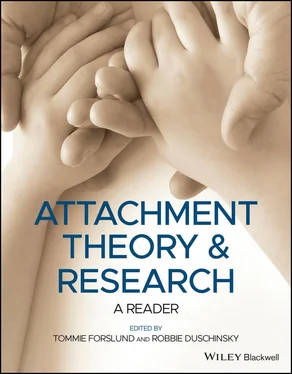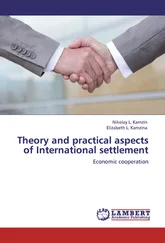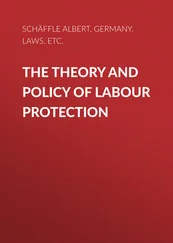The anticipation of any of these kinds of situation, and particularly the first two which appear to be the main ones, at once motivates him to take action intended to avoid their developing. Such ‘action’ may be of many kinds and will vary both in regard to the decisiveness with which a plan is made and in regard to whether or not it is actually executed. Irrespective of the mode of action resulting and irrespective, too, of which kind of danger situation is anticipated, the subjective states accompanying anticipation and avoidance appear to be the same: they are those of expectant anxiety.
The division of danger situations into two main classes, namely ( a ) and ( b ) above, is consistent with the empirical findings presented in a recent paper by Dixon, de Monchaux and Sandler (1957): a statistical analysis of patients’ fears showed that they tend to cluster into ‘fear of hurt’ and ‘fear of separation’. 15 As these authors point out, moreover, it is consistent with Freud’s distinction between anxieties relating to castration and those associated with loss of object. It will be clear, however, that the two classes I have defined are more inclusive than Freud’s: in the scheme presented here castration anxiety and separation anxiety each represent a particular albeit important example of a broader class. The third class defined above, ( c ), was the first to be discussed by Freud and is present in his theorizing from 1894 onwards.
It may perhaps be asked why the term ‘anxiety’ has been chosen to denote, in combination with a qualifying word, two such different emotional states as are referred to by ‘primary anxiety’ and ‘expectant anxiety’. There are two reasons. First, as Freud pointed out (1926, p. 165), anxiety carries with it a note of uncertainty. This is true both of primary anxiety, where it is uncertain whether or not the individual will reach a terminating situation, and of expectant anxiety, where the subject is uncertain whether or not he can prevent the danger situation materializing. The second reason is that I believe both classes play a large part in the genesis of neurotic anxiety. A note on questions of terminology, with particular reference to Freud’s usage, will be found in the Appendix.
This is a convenient moment to attempt a summary. We have now differentiated three classes of situation and three classes of behaviour, together with the corresponding subjective accompaniments to which they commonly give rise. The word ‘commonly’ is of importance, since situations can evoke behaviour (and its corresponding subjective experience) only when the organism is in an appropriate state. In the following tabulation the organism is assumed to be in such a state:
| Situations |
Behaviour |
Subjective accompaniment |
| 1. Which activate an instinctual response system without providing for its termination |
Persistent activation of response |
Primary anxiety |
| 2. Which activate instinctual response systems mediating escape or ‘freezing’ |
Escape or ’freezing’ |
Fright |
| 3. Which, if no action is taken, it is anticipated will so develop that |
|
|
| instinctual response systems mediating escape or ‘freezing’ will be activated |
|
|
| the haven of safety will be lostan instinctual response system will be activated in conditions unlikely to provide for its termination |
Avoidance |
Expectant anxiety |
In real life more than one situation may be present at once and behaviour of more than one kind and level result. Thus at the sound of an air‐raid warning each member of a family may experience expectant anxiety in regard to the possibility of harm coming both to themselves and their loved objects and may take precautions accordingly; whilst the whistle of a bomb may excite both escape and clinging responses simultaneously. Although in them the function of foresight, dependent on an appreciation of causal relationships, may be well developed, the example serves to emphasize that the primitive non‐foresightful instinctual responses none the less persist. During the course of development, it seems, we move from a condition in which we possess only the more primitive response systems to a condition in which we are equipped not only with these but also with the capacity for foresightful action. During maturity the extent to which primitive instinctual responses, action based on foresight, or both in combination are likely to mediate our behaviour on a particular occasion is a complex matter. It is one to which I hope to give further attention in a later paper on defences.
Before proceeding to a systematic discussion of separation anxiety, I wish to emphasize afresh that, although we have become caught up in sketching part of a revised theory of anxiety, this is not the purpose of the paper. Our problem is that of trying to understand separation anxiety. Adequately to formulate a comprehensive theory of anxiety would require a broader approach: in particular it would need to give close attention to anxiety arising from the threat of psychic disorganization.
Ingredients of Separation Anxiety
From the foregoing it will be clear that, according to the hypothesis advanced, separation anxiety is initially a form of primary anxiety, with or without the addition of fright, and that, as the infant develops, anxiety based on learning comes to be added. The reasoning behind this hypothesis has already been presented. My confidence in it springs from my belief that it provides a better explanation of observations of infants and young children than do other hypotheses and is enhanced by the fact that it seems also to fit comparable observations of the young of other species. These will be reviewed.
In very many species of bird and mammal the young show signs of anxiety when removed from their parents. The ‘lost piping’ of young ducklings who have become attached to and have temporarily lost a mother figure is a familiar example. The behaviour of infant chimpanzees in such situations is well recorded. Since it resembles closely, though in slightly exaggerated form, what we see in humans and seems almost certainly to be homologous, it is instructive to examine it. I shall draw on three accounts. Two (Kellogg & Kellogg, 1933; Hayes, 1951) give detailed information about two infant chimpanzees who were ‘adopted’ and brought up in a human home; the third, that by Yerkes (1943), who had prolonged experience of young chimpanzees living in captivity with their own parents, presents generalizations based on many cases. All three agree on the intensity of protest exhibited and, by implication, the anxiety experienced when a baby chimpanzee loses its mother‐figure.
Mrs. Hayes recounts how Vicki, a female whom she adopted at 3 days, would, when aged 4 months, cling to her foster‐mother ‘from the moment she left her crib until she was tucked in at night. … She sat on my lap while I ate or studied. She straddled my hip as I cooked. If she were on the floor, and I started to get away, she screamed and clung to my leg until I picked her up. … If some rare lack of vigilance on her part let a room’s length separate us, she came charging across the abyss, screaming at the height of her considerable ability.’
The Kelloggs, who did not adopt their female chimp, Gua, until she was 7 months old and who kept her for 9 months, report identical behaviour. They describe ‘an intense and tenacious impulse to remain within sight and call of some friend, guardian, or protector. Throughout the entire nine months … whether indoors or out, she almost never roamed very far from someone she knew. To shut her up in a room by herself, or to walk away faster than she could run, and to leave her behind, proved, as well as we could judge, to be the most awful punishment that could possibly be inflicted. She could not be alone apparently without suffering.’
Читать дальше












